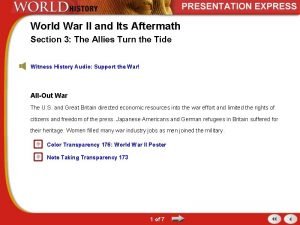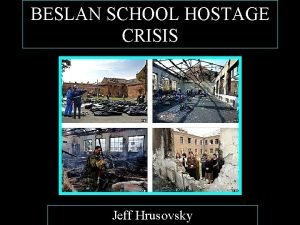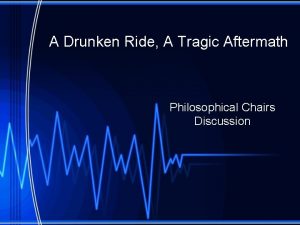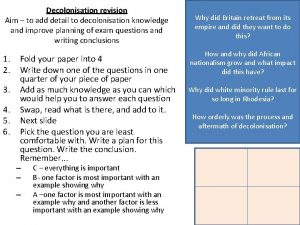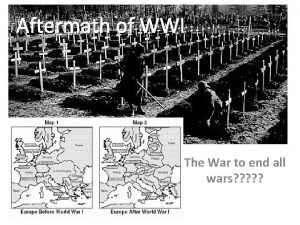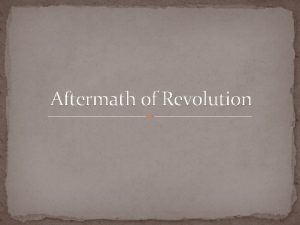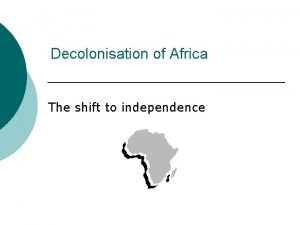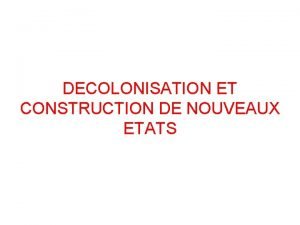How orderly was the aftermath of decolonisation C








- Slides: 8

How orderly was the aftermath of decolonisation? C aim – to explain how orderly the aftermath was in different countries B/A aim – to explain how orderly the aftermath was in detail • From what you know about Nigeria and Zimbabwe, how orderly would you say the aftermath of decolonisation was in these countries?

Nigeria 1. 2. 3. 4. 5. 6. 7. 8. 9. Nigeria gained independence in 1960 as a coalition of the Islamic Northern parties and Southern Christian parties with a PM and the Queen as the head of state 1961 – a southern region called Southern Cameroon opted to join the Republic of Cameroon which made the Northern part of the country much larger than the South 1963 – Nigeria became a republic 1966 – disequilibrium and the perceived corruption of the electoral and political process led to several back to back military coups. Eventually the Northern Muslims won their military coup. Many of the Southern Christians were killed – especially those of Igbo descent. 1967 – The Igbo declared themselves as independent as the Republic of Biafra as they hated the violence they had experienced. The Northerners and some of the other southerners attacked them. The Nigerian Civil War started. 1970 –Nigerian Civil War ended – 1 -3 million died from the war and related problems. Various powers were involved helping different groups. Biafra stayed with Nigeria. 1975 – the Northern Muslims who won the military coup were overthrown by a bloodless coup 1976 – another coup succeeded 1979 – the previous coup gave power to an elected group 1. Make a key 2. Highlight what was orderly and disorderly in the aftermath of decolonisation in Nigeria 3. How disorderly was this aftermath of decolonisation? 4. What caused this amount of order or disorder?

. 1. Make a key Highlight what was orderly and disorderly in the aftermath of decolonisation in Zimbabwe 3. How disorderly was this aftermath of decolonisation? 4. What caused this amount of order or disorder? Zimbabwe • 1980 – Mugabe and ZANU secured a landslide victory • 1982 -1985 – Matabeleland massacres of a rival ethnic group who followed Nkomo’s ZAPU to the Shona dominated ZANU. Around 20, 000 Matabeles were killed. • 1990 s – Mugabe’s ZANU party won more landslide victories, these are thought to have been corrupt, different grousp went on strike over salaries. • 2000 – 70% of arable land was still owned by white settlers. Mugabe forcibly reallocated the lands to black Zimbabweans. Agricultural production dropped. • 2000 s – Mugabe was accused of further vote rigging. Illegal slums were demolished leaving many homeless. Zimbabwe is in hyperinflation with huge rates of unemployment.

Ghana 1. 2. 3. 4. 5. 6. 7. 8. 9. 10. 11. 2. 1. Make a key Highlight what was orderly and disorderly in the aftermath of decolonisation in Ghana 3. How disorderly was this aftermath of decolonisation? 4. What caused this amount of order or disorder? In 1956 the British agreed to give Ghana independence as long as the CPP a ‘reasonable’ majority – they won 72 out of 104 seats so independence was given. Nkrumah became PM, joined the Commonwealth and the Queen was the monarch. 1957 – the deportation act said that any non-Ghananian who was not in the interest of the public good could be deported, ethnic/religious/regional parties banned 1958 – Preventive Detention Act gave power to the PM to detain individuals up to 5 years without trial. This helped to silence their opponents. 1960 – Ghana became a republic and Nkrumah became president. Nkrumah then proclaimed himself president for life and the CPP as the sole party. 1961 – between 400 and 2000 of Nkrumah’s opponents had been detained Nkrumah spent lots of money on hosting pan-African conferences. Nkrumah justified the restricted freedoms by spending lots of money on road building, mass education health services and constructing the Akosombo Dam. This was very expensive. By 1961 cuts were made in spending and taxes raised. Protests began to emerge from farmers and within his own party. 1962 – an assassination plot was discovered and the plotters were sentences harshly by an unfair court. 1964 – Ghana officially became an single-party state with one candidate for the presidency. 1966 – the National Liberation Council overthrew the CPP in a military coup saying the CPP and Nkrumah were abusive and corrupt. They made arrangements for democracy to return. 1968 – different political parties allowed 1969 – free elections held.

Kenya 1. Make a key 2. Highlight what was orderly and disorderly in the aftermath of decolonisation in Kenya 3. How disorderly was this aftermath of decolonisation? 4. What caused this amount of order or disorder? 1963 – Kenya becomes independent under Kenyatta, despite the British hoping for a ‘moderate’ leader. KANU and KADU political parties. 2. 1964 – Kenyatta’s KANU party was the only political party as KADU voluntarily dissolved itself. 3. 1966 – KPU broke away from KANU. KPU were mainly Luo people. 4. 1969 – Member of government assassinated which led to hostility between Kikuyu and Luo ethnic groups. Riots then broke out in Luo areas and KPU was banned. One party state again. 5. In 1963 the Kenyans were fighting a war against Somalians living in Kenya who wanted to unite a part of Northern Kenya with Somalia. 6. 1967 – Ceasefire reached with Somalians living in Northern Kenya In the 1960 s and 1970 s Kenyans seized back land from white settlers and was given to mainly the Kikuyu, Embu and Meru ethnic groups – only 30% of the population – as they were the ones with most of the political power. 7. 1978 – Kenyatta died and the deputy leader of KANU became president.

Somalia • • 1. Make a key 2. Highlight what was orderly and disorderly in the aftermath of decolonisation in Somalia 3. How disorderly was this aftermath of decolonisation? 4. What caused this amount of order or disorder? • • 1960 – Somalia became independent with various elected leading representatives. 1961 – popular referendum ratified the new constitution 1967 – New PM appointed by the previous PM 1969 – the new PM was shot dead by his own bodyguard and a military coup d’etat followed. The Somalian army took power under their leader Major General Barre. They faced no opposition. Barre soon after became the leader of the whole country. They put into place public works programmes, improved education and nationalised industry and land. It was a one party state. They introduced more Islamic ideas into ruling the country. 1977 – The Somalians invaded a part of Ethiopia which was very valuable. The Russians and Cubans came to help Ethiopia’s Communist regime and pushed the Somalians out by 1978. The Somalians now joined with the USA. 1979 – new constitution made and new elections help but Barres government still continued to rule as a one party state.

• How orderly was Africa when it was colonised? • How orderly was it after colonisation? • Did decolonisation lead to more or less disorder in Africa? • Was it better for the African people for their countries to be decolonised? • What caused this greater amount of disorder?

• How accurate is it to say that the transition to independence led to increased political instability in east and west Africa in the 1960 s and 1970 s? • Homework – due Thursday 26 th March

